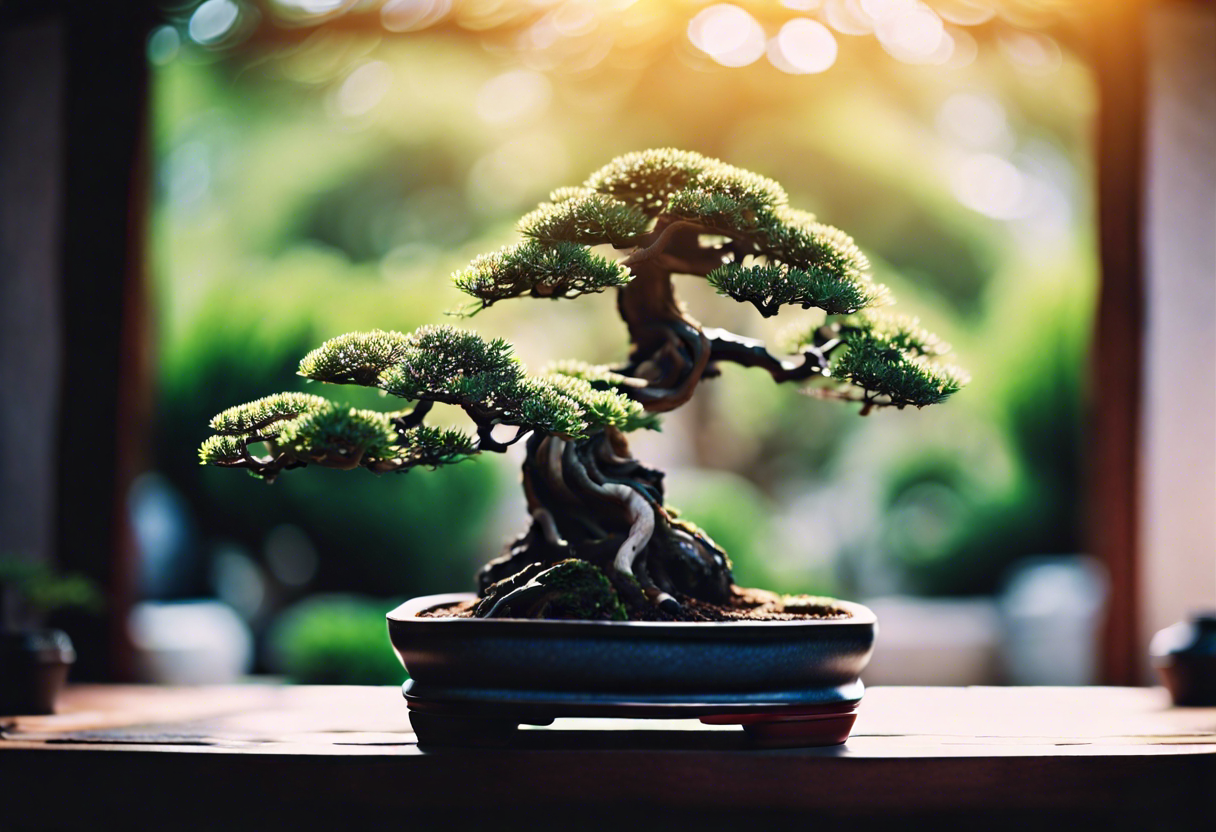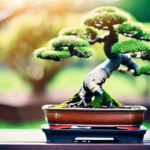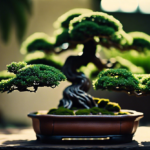Understanding the Basics of Bonsai Tree Styling for Beginners
When delving into the art of bonsai, beginners may find the styling aspect to be both exciting and challenging. Bonsai tree styling involves shaping and pruning the tree to embody a miniature version of its larger counterpart. It is essential to grasp the fundamental principles before diving into the hands-on aspects of styling.
One of the key elements of bonsai tree styling is understanding the different styles available. The most common bonsai styles include formal upright, informal upright, cascade, semi-cascade, and literati. Each style has its unique characteristics, and beginners should choose a style that aligns with their skill level and aesthetic preferences.
Another crucial aspect to consider is the choice of the right tree species. Some tree species are more forgiving and resilient, making them ideal for beginners. Examples of beginner-friendly species include the Ficus, Chinese Elm, and Juniper. These species are hardy and respond well to styling techniques, making them perfect for honing your skills.
Furthermore, basic pruning and wiring techniques are fundamental skills that beginners should focus on mastering. Pruning helps maintain the shape and size of the bonsai, while wiring allows you to sculpt the tree and guide its growth. It is essential to approach these techniques with caution and patience to avoid damaging the tree.
As a beginner, it is essential to research and educate yourself on the specific care requirements of your chosen bonsai species. Factors such as sunlight exposure, watering needs, and soil composition play a significant role in the health and vitality of your bonsai tree. By understanding and meeting these requirements, you can ensure that your bonsai thrives and remains beautiful for years to come.
Delving into bonsai tree styling as a beginner can be a rewarding journey filled with learning opportunities. By grasping the basics of bonsai styling, choosing the right tree species, and mastering essential techniques, you can embark on a fulfilling experience of nurturing and shaping your bonsai tree. Remember to approach bonsai styling with patience, dedication, and a willingness to learn, and you will soon find yourself creating stunning miniature masterpieces.
Essential Tools Required for Bonsai Tree Styling
When delving into the art of bonsai tree styling, having the right tools is essential for success. As a beginner, acquiring the proper tools will not only make the styling process more manageable but also enhance your overall experience in cultivating these miniature trees. Here are some of the must-have tools you will need to embark on your bonsai styling journey:
Pruning Shears
Pruning shears are a fundamental tool for maintaining the shape and size of your bonsai tree. These shears allow for precise cuts and are essential for trimming branches, twigs, and leaves with accuracy. Invest in a quality pair of pruning shears to ensure clean cuts that promote the health and growth of your bonsai tree.
Wire Cutters
Wire is often used in bonsai styling to shape the branches of the tree. Wire cutters are necessary to trim and remove the wire once the desired shape has been achieved. Using wire cutters designed specifically for bonsai ensures that you can make clean cuts without damaging the branches or bark of the tree.
Bonsai Wire
Bonsai wire plays a crucial role in styling your tree by facilitating the bending and shaping of branches. When selecting bonsai wire, opt for aluminum wire as it is easy to manipulate and gentle on the tree. Make sure to choose the appropriate thickness of wire based on the size and flexibility of the branches you wish to shape.
Root Rake
A root rake is essential for repotting and root pruning your bonsai tree. This tool helps in loosening and untangling the roots during repotting to promote healthy growth. Additionally, a root rake can be used to remove debris and old soil from the root system, allowing for better aeration and nutrient absorption.
Bonsai Soil
Choosing the right soil is critical for the health and development of your bonsai tree. Bonsai soil is specially formulated to provide adequate drainage and aeration while retaining moisture for the roots. Opt for high-quality bonsai soil that is well-draining to prevent waterlogged roots and ensure optimal growth conditions for your tree.
Having the essential tools for bonsai tree styling is paramount for beginners looking to embark on this rewarding journey. By equipping yourself with the right tools, you can effectively shape and nurture your bonsai tree, unlocking the full potential of these miniature masterpieces.
For more information on bonsai tree styling tools and techniques, you can visit Bonsai Empire for comprehensive resources and insights on all things bonsai-related.
Step-by-Step Guide to Wiring Techniques for Bonsai Trees: A Beginner’s Manual
Styling a bonsai tree is an art form that requires patience, skill, and precision. One of the essential techniques in shaping your bonsai tree is wiring. Wiring helps in manipulating the branches and trunk of the tree to achieve the desired design. Here is a step-by-step guide to wiring techniques for beginners looking to style their bonsai trees effectively.
Understanding the Basics:
Before starting the wiring process, it’s crucial to understand the growth pattern and natural shape of your bonsai tree. Take time to study your tree and visualize the design you want to achieve. Different tree species may require specific wiring techniques, so research your tree’s requirements beforehand.
Choosing the Right Wiring Tools:
To wire your bonsai tree effectively, you will need the right tools. Basic tools include aluminum or copper wire, wire cutters, and pliers. The wire should be approximately one-third the thickness of the branch you are wiring. Using the correct tools will ensure precision and prevent damage to your tree.
Step-by-Step Wiring Process:
- Selecting Branches: Start by choosing the branches you want to wire. Select primary branches that will form the tree’s structure.
- Wrapping the Wire: Take the selected wire and wrap it around the branch carefully. Start from the base and work your way up, ensuring even spacing between each coil.
- Bending the Branch: Once the wire is in place, gently bend the branch to the desired position. Take care not to force the branch into unnatural angles to avoid damaging the tree.
- Securing the Wire: Use pliers to secure the wire in place by gently twisting it around the branch. Make sure the wire is tight enough to hold the branch in position but not too tight to restrict growth.
- Monitoring and Adjusting: Regularly check the wired branches to ensure they are growing smoothly along the desired path. Adjust the wires as needed to maintain the shape and prevent them from cutting into the bark.
Patience and Care:
Wiring is a delicate process that requires patience and care. Avoid leaving wires on for too long, as they can bite into the bark as the tree grows. Remove the wire once the branch has set in the desired position to prevent scarring.
By following this step-by-step guide to wiring techniques for bonsai trees, beginners can effectively style their trees and create beautiful designs. Remember to practice regularly and seek guidance from experienced bonsai enthusiasts to enhance your skills further.
For more in-depth information on advanced wiring techniques and bonsai tree styling tips, visit Bonsai Empire for expert guidance and resources.
Understanding the Basics of Bonsai Tree Styling for Beginners
When it comes to bonsai tree styling, beginners often feel overwhelmed by the intricate artistry involved. However, with the right guidance and approach, even novice enthusiasts can create stunning bonsai trees. One essential aspect to consider is choosing the right bonsai tree styles that align with your skill level. Understanding the various styles, such as formal upright, informal upright, cascade, and semi-cascade, can help beginners visualize the outcome they want to achieve with their bonsai trees. Each style has its unique characteristics and requirements, making it crucial to select one that suits your level of expertise.
For beginners, the formal upright style is often recommended as it is relatively straightforward to execute compared to more complex styles like cascade or semi-cascade. This style embodies the traditional upright appearance commonly associated with bonsai trees, making it a great starting point for those new to bonsai tree styling. The informal upright style, while slightly more challenging, offers a more natural and organic look that appeals to beginners looking to explore different aesthetics.
In addition to choosing the right style, beginners should also focus on mastering basic techniques such as pruning, wiring, and shaping. These techniques play a crucial role in shaping the overall appearance of the bonsai tree and are essential skills that every bonsai enthusiast should learn. Pruning helps control the growth of the tree and encourages the development of a compact canopy, while wiring allows for the precise positioning of branches to achieve the desired silhouette.
Moreover, proper care and maintenance are key to successful bonsai tree styling. Beginners should familiarize themselves with the specific needs of their chosen tree species, including light requirements, watering schedule, and fertilization. By providing the necessary care and attention, beginners can ensure that their bonsai trees thrive and continue to develop beautifully over time.
To further enhance their bonsai tree styling skills, beginners can seek guidance from experienced bonsai artists, attend workshops, and explore online resources dedicated to bonsai cultivation. These platforms offer valuable insights, tips, and inspiration to help beginners hone their styling techniques and create stunning bonsai trees.
Mastering the basics of bonsai tree styling is an exciting journey that requires patience, practice, and a genuine passion for the art form. By understanding the fundamentals of bonsai tree styles, practicing essential techniques, and providing proper care, beginners can embark on a fulfilling and rewarding bonsai experience that will yield beautiful creations for years to come.
Understanding the Common Mistakes to Avoid When Styling Bonsai Trees for Beginners
When delving into the art of bonsai tree styling as a beginner, it’s essential to be aware of common mistakes that can hinder your progress and the health of your bonsai. By understanding and avoiding these pitfalls, you can set yourself up for success in cultivating stunning bonsai trees.
One common mistake beginners make when styling bonsai trees is over-pruning. It’s crucial to remember that bonsai trees are living organisms that need their leaves to photosynthesize and grow. Over-pruning can weaken the tree and stunt its development. Instead, focus on selective pruning to maintain the tree’s health and shape.
Another mistake to avoid is improper wiring techniques. While wiring is a valuable tool in shaping bonsai trees, incorrect wiring can damage the tree and even cause injuries. Make sure to learn proper wiring methods and use appropriate tools to prevent harm to your bonsai tree.
Furthermore, neglecting proper watering and fertilizing schedules is a common error among beginners. Bonsai trees require consistent care to thrive, including regular watering and fertilizing. Failure to adhere to these routines can result in the tree becoming unhealthy and losing its vigor. Research the specific needs of your bonsai tree species and create a care schedule to ensure its well-being.
Moreover, using the wrong soil mix can have detrimental effects on your bonsai tree. Each species of bonsai tree has unique soil requirements, and using the wrong soil mix can lead to root rot or nutrient deficiencies. Invest time in understanding the soil needs of your bonsai tree and choose a suitable soil mix to promote growth and vitality.
Neglecting to consider the appropriate styling for your skill level is a mistake many beginners make. It’s essential to start with simple styling techniques and gradually progress to more advanced methods as you gain experience and confidence. Trying complex styling too soon can overwhelm you and potentially harm the tree.
By being mindful of these common mistakes and taking proactive steps to avoid them, beginners can enhance their bonsai tree styling journey and cultivate healthy, beautiful trees that bring joy and tranquility. Remember, patience and learning from mistakes are integral parts of mastering the art of bonsai tree styling.
Conclusion
In the world of bonsai tree styling for beginners, understanding the basics is crucial. By grasping the fundamental principles of shaping and nurturing these miniature trees, enthusiasts pave the way for a fulfilling journey into the art of bonsai. Learning about the various styles, such as formal upright, informal upright, slanting, cascade, and semi-cascade, provides a solid foundation for beginners to start shaping their bonsai trees. With this knowledge, individuals can appreciate the beauty and tranquility that bonsai trees bring to their surroundings, making the cultivation process all the more rewarding.
Equally important in bonsai tree styling is having the right tools at your disposal. Essential tools such as concave cutters, knob cutters, wire cutters, branch benders, and jin pliers enable beginners to shape and manipulate their bonsai trees with precision and finesse. Investing in quality tools not only ensures the health and longevity of the bonsai tree but also enhances the overall styling process, making it more efficient and enjoyable for beginners.
Mastering wiring techniques is a crucial aspect of bonsai tree styling for beginners. By following a step-by-step guide to wiring, individuals can learn how to position and secure branches, create movement and direction, and achieve balanced proportions in their bonsai trees. Through practice and patience, beginners can hone their wiring skills and bring their artistic vision to life, transforming ordinary trees into stunning bonsai masterpieces.
When it comes to choosing the right bonsai tree styles for your skill level, beginners should start with simpler designs that align with their experience and expertise. Beginning with basic styles such as formal upright or informal upright allows newcomers to familiarize themselves with shaping techniques and develop their artistic sensibilities before progressing to more advanced styles like cascade or semi-cascade. By matching their skill level with appropriate bonsai tree styles, beginners can build confidence and competence in bonsai tree styling over time.
Despite the joys of bonsai tree styling, beginners should be aware of common mistakes to avoid during the cultivation process. Overwatering, improper pruning, using the wrong soil mix, neglecting pest control, and applying too much or too little fertilizer are pitfalls that can hinder the growth and development of bonsai trees. By staying vigilant and attentive to the needs of their bonsai trees, beginners can nurture healthy, vibrant specimens that showcase their dedication and passion for this ancient art form.
Mastering the art of bonsai tree styling for beginners entails a deep appreciation for the craft, a commitment to learning and practicing essential techniques, and a willingness to embrace challenges and setbacks along the way. By understanding the basics, acquiring the right tools, honing wiring techniques, choosing suitable styles, and avoiding common mistakes, beginners can embark on a fulfilling bonsai journey that enriches their lives and connects them to the beauty of nature in a profound and meaningful way.


